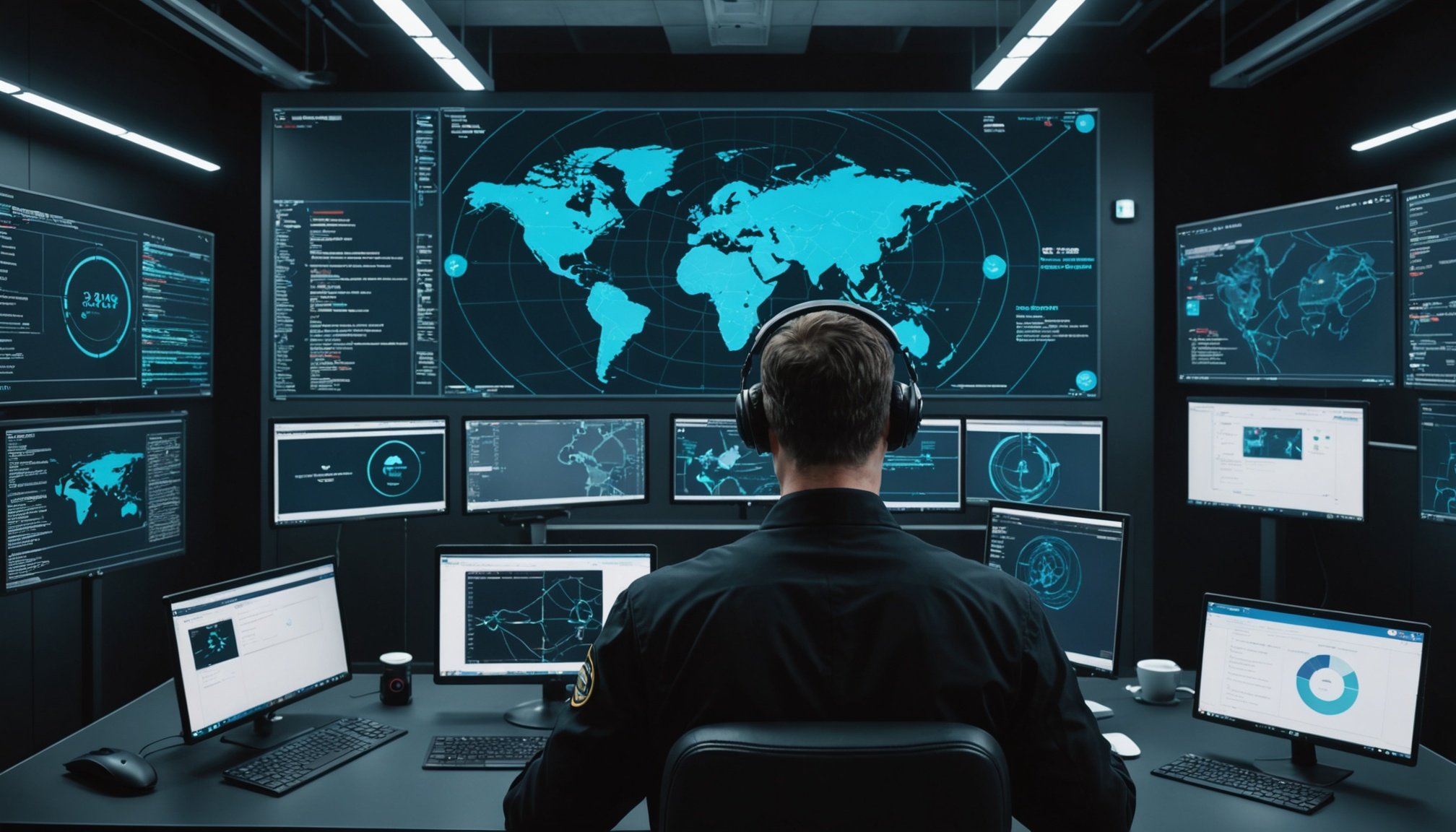Overview of AI-Driven Cybersecurity Technologies
With the rapid advancement in technology, AI cybersecurity solutions have become a crucial component in safeguarding digital environments. These solutions harness the power of machine learning in security to provide advanced threat detection capabilities, making them indispensable in the fight against cyber threats.
AI-driven cybersecurity technologies refer to systems and protocols that employ artificial intelligence algorithms, notably machine learning algorithms, to detect, analyse, and mitigate cyber threats in real-time. These systems can swiftly identify vulnerabilities by learning from vast datasets, adapting to emerging threats which traditional methods may overlook.
Also read : Revolutionizing aviation: unleashing advanced ai technologies for predictive maintenance solutions
The cornerstone of real-time threat detection systems is their capacity to process immense streams of data, identifying anomalous patterns indicative of potential breaches. They utilise machine learning to differentiate between legitimate and malicious activities, thereby providing an advanced layer of security.
The integration of machine learning algorithms is pivotal in refining the ability of these technologies to predict and preemptively tackle vulnerabilities. By continually learning from historical data, these algorithms enhance the system’s resilience, enabling it to respond more efficiently to newer threats.
Also read : Discover how the ai detector transforms content authenticity
In conclusion, AI-driven cybersecurity represents a significant leap forward in safeguarding digital assets, offering both proactive and reactive solutions to an ever-evolving landscape of cyber risks.
Successful Case Studies of AI Implementation
Numerous organizations have made significant strides using AI-driven security solutions, transforming real-world applications into cybersecurity success stories. An analysis of these notable organizations showcases how AI is leading the charge in modern security strategies.
One compelling example is a multinational financial services firm that integrated AI case studies into its security protocol. Their implementation included advanced AI analysis to detect unusual patterns in network traffic, effectively mitigating potential threats. Within months, this approach resulted in a reduction of security breaches by over 50%, demonstrating the measurable outcomes achievable through AI implementation.
Another example stems from an international tech company focusing on cybersecurity success stories. By deploying machine learning algorithms to automate threat detection, incidents decreased by 60%. The firm also found enhanced efficiency, with AI handling analyses previously performed manually, freeing up valuable human resources.
From these deployments, key lessons learned include the importance of continuous monitoring and adaptation. AI systems need regular updates to adapt to new threats. Furthermore, human oversight remains essential to complement AI’s capabilities, ensuring a robust and resilient security framework. These insights provide valuable guidance for organizations seeking to enhance their cybersecurity measures through AI.
Benefits of Real-Time Threat Detection
Understanding the advantages of real-time monitoring is crucial in today’s dynamically changing threat landscape. Real-time monitoring offers unparalleled speed in identifying threats, especially when compared to traditional security methods. It enables faster recognition of potential risks, markedly reducing the time between threat detection and response.
Proactive security measures are a cornerstone of real-time threat detection. These measures anticipate and mitigate threats before they escalate, allowing for a more efficient allocation of resources. This proactive approach significantly decreases the occurrence of false positives, which traditionally consume unnecessary time and effort.
Another significant benefit is the improvement in threat response efficiency. Real-time systems bolster incident response capabilities by providing timely alerts and actionable intelligence. This leads to a more coordinated and effective response, minimizing the potential damage threats can cause.
- Speed: Rapid detection of vulnerabilities.
- Efficiency: Enhanced response to threats, reducing potential impact.
- Accuracy: Fewer false positives, optimizing resource allocation.
The result is a framework capable of not just identifying threats quickly, but also effectively coordinating defensive measures, thus ensuring a more secure environment.
Comparison with Traditional Cybersecurity Methods
In the ever-evolving landscape of digital protection, comparing AI vs traditional security methods reveals significant differences in both operation and effectiveness. Traditional cybersecurity relies heavily on pre-defined rules and known threat signatures. These detection methods require continuous updates and often struggle to keep pace with the sophisticated techniques used by cybercriminals today.
Traditional cybersecurity measures are generally reactive. They focus on identifying and mitigating threats based on past patterns. This can be a critical limitation when facing new, unknown threats that do not match their outdated databases. Consequently, threats can go undetected until damage is already done.
AI, on the other hand, enhances security by employing machine learning algorithms that detect anomalies in real-time. This allows systems to identify potential threats dynamically, adapting as new threats emerge. AI-based security solutions can even predict potential attack vectors by analysing patterns, thus preventing an incident before it occurs.
Therefore, integrating AI into a security strategy can vastly improve threat detection and response capabilities. While traditional cybersecurity lays the foundational groundwork, AI serves as a crucial enhancement, offering an adaptive, proactive approach to modern cyber threats.
Future Trends in AI-Driven Cybersecurity
Evolving AI technologies are shaping the future of cybersecurity, promising significant advancements in how we combat threats. As cyber threats become more sophisticated, AI tools are increasingly being deployed to detect and mitigate risks with greater precision. These technologies are expected to revolutionise security protocols by providing real-time threat detection, thereby reducing response times significantly.
Predictions suggest that AI will play a pivotal role in identifying previously unknown threats and evolving attack patterns. Innovations like machine learning and intelligent algorithms can analyse vast datasets to recognise anomalies, predict potential breaches, and automate threat responses. This enables a proactive rather than reactive approach to cybersecurity.
The continuous evolution of security solutions is crucial in staying ahead of cyber threats. By integrating AI-based systems, organisations can maintain robust defences against a dynamic threat landscape. Regular updates to these systems, leveraging evolving technologies, ensure they remain effective against emerging challenges.
Technologically savvy yet accessible solutions are vital so that businesses of all sizes can benefit from these advancements without needing extensive expertise. In doing so, AI-driven cybersecurity not only protects data but also fosters trust and confidence in digital interactions.
Practical Recommendations for Businesses
Ensuring robust security best practices is paramount for businesses today. One crucial step is for businesses to assess their current security posture. This process should include evaluating existing vulnerabilities and determining the effectiveness of current security protocols. Businesses can utilise internal audits and third-party assessments to gain a comprehensive understanding of their security landscape.
When implementing AI solutions, it is imperative to integrate them seamlessly into the existing frameworks. This involves selecting AI tools that complement your current infrastructure, ensuring minimal disruption. Furthermore, it’s essential to tailor AI functionalities to specific business needs, enhancing efficiency while maintaining security standards.
Businesses must also adopt comprehensive business cybersecurity strategies. These strategies should incorporate AI-driven tools for threat detection and response. AI can rapidly analyse data to identify potential threats, allowing businesses to act swiftly. However, AI tools require continuous monitoring and updating to stay effective against evolving threats.
Finally, fostering a culture of ongoing training and adaptation to new technologies is vital. Employees should receive regular training on emerging threats and the latest security tools. This proactive approach not only enhances security but also empowers organisations to remain agile in the face of technological advancements. Adapting these practices can bolster a business’s security stance substantially.











